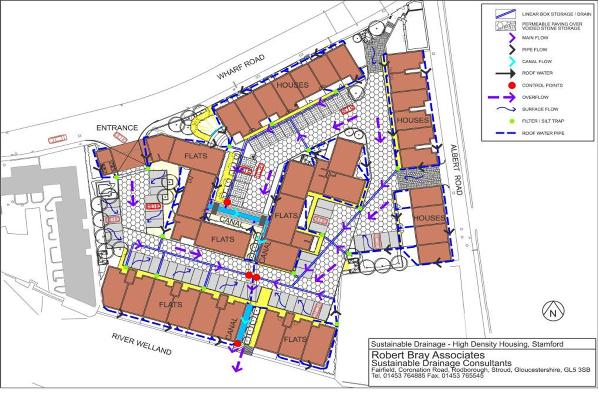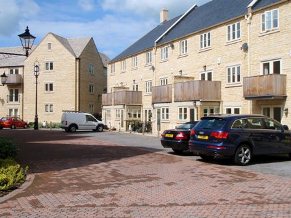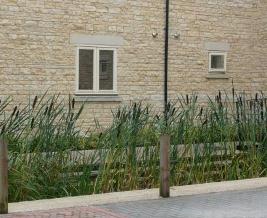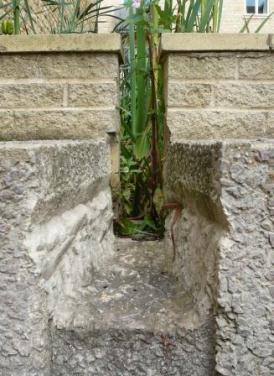Where
Location
Riverside Court is located on the north bank of the River Welland in Stamford.
Description
Riverside Court was the re-development of an electricity sub-station comprising of high density urban housing around two loosely defined courts. These open directly onto shared pedestrian and vehicular space with an access street entering under an arch from Wharf Road. The development achieves a density of 104 units a hectare with 72 units in 0.69ha, which is well above the design standards recommended in PPS 3 Housing. The idea of betterment has resulted in an increased rate of runoff justified on the grounds that stored water is best released before flood water enters Stamford from the wolds higher up in the catchment.
 |
|
Figure 1 Plan of the Stanford SuDS scheme (Bob Bray) Click on image to enlarge |
SuDS used
Permerable paving, rills and canals. Permeable paving sometimes augmented by shallow geocellular storage.
 |
 |
|
Figure 2 Car park using permeable paving (Bob Bray) |
Figure 3 Planted rill |
How it works
Vehicular surfaces in each court and the access street together with some of the parking spaces use
 |
|
Figure 4 Rill leading to the Welland River |
permeable pavements to achieve collection, cleaning and storage of runoff in a very confined space with no land take. Roof water is collected through silt traps that flow into diffuser boxes within the voided stone sub-base or directly to planted rills. In some places the voided stone construction is enhanced by shallow geocellular drainage.
The whole pavement contributes clean water to a courtyard canal and rill before flowing through three control points into a river side canal, that reflect the three sub-catchments, identified within the development. A slot weir to the River Welland controls the flow down a stepped rill to the waters edge.
The planted landscape beds control the flow of the courtyards are conventional planters but the planted canals and rills raise the landscape quality significantly. They also provide an exceedance route through the housing development.
Specific details
The courtyard design was not constrained by adoption requirements as the whole development is maintained by a management company.
Design & construction
Despite repeated visits, a change of site agent towards the end of the contract resulted in extensive surface silt contamination of the pavement. However, following a brushing and suction cleaning of permeable block paving, the performance has been restored as there were no reports of problems during heavy rain in either 2007 or 2008. Indeed, following heavy rain in July 2007, the site was reported to be dry on the surface with no outflow when the rest of Stamford was covered in puddles and standing water.
Benefits & achievements
The following benefits of SuDS were highlighted through this scheme:
-
design interaction with sympathetic professionals can deliver exciting schemes
-
permeable pavement can deliver a source of clean water for amenity features such as canals, rills and other water features with negligible land take.
-
permeable pavement can be rehabilitated after siltration on the surface and performs well in heavy rainfall
-
an urban design approach delivers high quality urban landscape
-
flexibility in design delivers exciting and easily maintained urban space
Challenges & lessons learnt
 |
|
Figure 5 Outlet from rill to the River Welland |
During 2007, a complaint was received from residents that the planted canals were unsightly and smelled following a long dry period in early summer. Immediate inspection revealed that minimum planting had been undertaken resulting in very slow establishment but that standing water was crystal clear with no smell whatsoever. It could be assumed that the poor appearance and still character of the water in the canals created concern to residents unfamiliar with water features near housing. Replanting was done in July and within three months the canals and rill were full of greenery and no comments have been communicated since that time.
SuDS can be used in:
-
High density housing as long as permeable surfaces are considered in the design.
-
Permeable paving can be rehabilitated following siltation
-
Well designed SuDS features contribute to the Urban Design quality.
The information on the Stamford project was provided by:
Bob Bray ,Robert Bray Associates, Fairfield, Coronation Road, Rodborough, Stroud, GL5 3SB
Back to top



